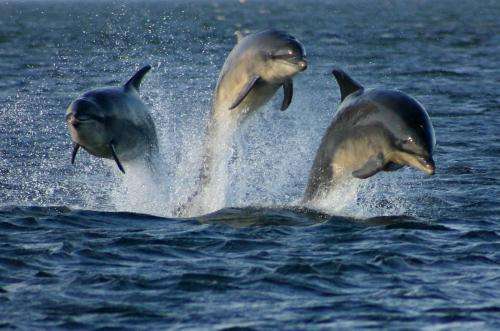Assessing noise impact of offshore wind farm construction may help protect marine mammals

Growth in offshore wind generation is expected to play a major role in meeting carbon reduction targets around the world, but the impact of construction noise on marine species is yet unknown. A group of scientists from the United Kingdom and the United States have developed a method to assess the potential impacts of offshore wind farm construction on marine mammal populations, particularly the noise made while driving piles into the seabed to install wind turbine foundations. Their work is published in the November issue of Environmental Impact Assessment Review.
"Pile-driving during the construction of offshore wind farms produces an incredible amount of noise," said Helen Bailey, one of a group of scientists at the University of Maryland Center for Environmental Science who are studying the impacts of wind turbines on the environment. "This is potentially harmful to marine species and has been of greatest concern to marine mammal species, such as protected populations of seals, dolphins and whales."
Their research is based on ongoing construction in and around the North Sea, where many proposed wind farm sites are on submerged offshore sandbanks that also provide important habitats for marine mammals and seabirds. Previously attention had focused on the potential impacts to birds, but this new work is looking at how to assess the potential long-term impact of construction on protected marine mammal populations, particularly harbor seals. In the United States, this type of assessment could be applied to wind turbine construction that may impact a number of endangered species, including the North Atlantic right whale, the humpback whale, and fin whale.
"Our framework takes a worst case assessment of the short term impacts of noise and how these may influence longer term population change, thereby providing information that allows regulators to balance their efforts to meet both climate change targets and existing environmental legislation," said the study's lead author Paul Thompson of the University of Aberdeen.
Harbor seals can be impacted by the noise in several ways. Loud construction activities can cause traumatic hearing injury or death at close range. The disturbances may lead seals to avoid the area and lose favorite feeding grounds, potentially causing greater competition in other areas. It could also have an impact on reproduction or survival rates. Changes in hearing sensitivity could make seals more vulnerable to predation, and make it more difficult to find food or to find mates.
More information: The study, "Framework for assessing impacts of pile-driving noise from offshore wind farm construction on a harbour seal population" is published in the November issue of Environmental Impact Assessment Review by Paul Thompson et al.: www.sciencedirect.com/science/ … ii/S0195925513000735


















